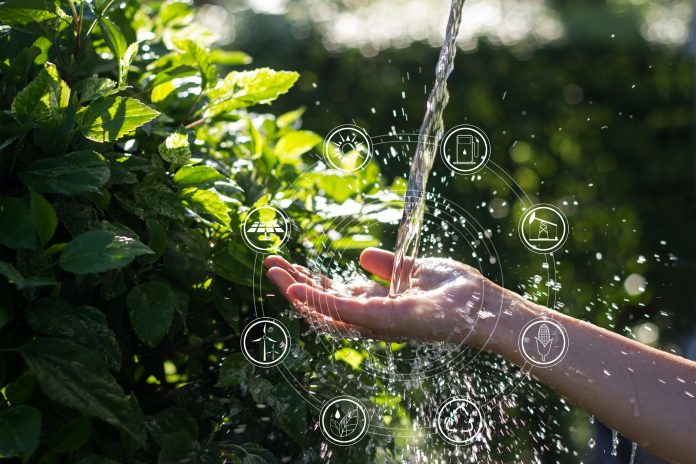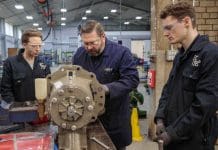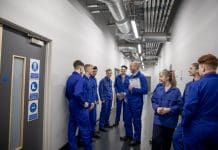BIM4Water focuses on the sustainability of skills needed to support digital engineering and transformation in the water sector
In November, the BIM4Water Skills Task Group hosted its first ever event, Make Your Talent Pool an Ocean, focused on bringing people from all backgrounds into the digital conversation. With an array of speakers, the event covered key topics from how to make inclusivity inclusive to digital career paths – side-stepping your way to the role you want; these sessions provided a stark reminder that as a sector, there are limited proactive efforts to change our resource shortages. Listen back at BIM4Water.
As the water sector enters the final months of Year 2 of AMP7, the pressure and workload are rising at an exponential rate and it is apparent that recruitment challenges are increasing, as there is only a “limited pool of digital resources”. So how can this pool be expanded to overcome these challenges and ensure readiness for AMP8, where there will be an even greater demand for digital delivery?
There is a need for readying the water industry with digital skillsets to assist and support resources and provide succession planning in AMP7 and beyond. It is clear that technology in the sector is not the issue anymore – people and culture are.
So how can the water industry start to make small changes to create the ripples required for wide scale impact?
STEM to STEAM
Firstly, academia. The majority of organisations are involved with the promotion and sponsorship of Science, Technology, Engineering and Mathematics (STEM) learning. This has always been part of the foundations of engineering and formed the basis of the tools required to pursue a career in this industry. However, the skills and demands are evolving as digital transformation occurs and the challenge is to keep pace with these changes.
BIM4Water believes that there should be a greater focus on STEAM learning, where “A” stands for alternative backgrounds. Let us become comfortable with hiring individuals from alternative industries, who think differently to the 10 people in a meeting room with engineering degrees.
However, with this comes responsibility: there needs to be the right support framework to ensure no in-balance in an individual’s strengths and weaknesses; it comes back to capability versus experience.
The key areas for an engineer’s development have always been focused on theoretical (design) and practical (site) skills, but there is a third area that can be nurtured through digital transformation: engineering collaboration and communication. These areas can be improved and facilitated through BIM adoption and there are many case studies to support this.
The curriculum of engineering degrees has historically lacked in digital subject-based content. There is a real opportunity here for organisations to help develop syllabuses and be actively involved in defining academic curriculums, to better support digital efficiencies. Bridging the skills gap between academia and industry; the importance of equipping graduates and apprentices with the right tools to feel confident in entering a changing world are key attributes for the trainee engineer.
Another challenge is how can academia and industry better teach the skills required to improve imagination, innovation and problem solving. How can they equip people for a digital world they are biologically not equipped to see and move away from analogue viewpoints? The focus in creating change and embedding it lies within mindset training over skillset. We need to approach problem solving with an alternative thought process. This is where diversity in the workforce becomes an enabler to innovate, to thinking differently and culturally, and as an organisation, develop a competitive advantage.
Recruitment and human resources (HR) have the greatest reach within an organisation and therein lies the greatest opportunity to empower cultural change. This department can start to remove barriers created by organisational systems and start to change the recruitment process. There needs to be a movement away from “peas in a pod” syndrome and the removal of affinity bias.
“An inclusive organisation cannot exist without a diverse workforce; an organisation must be inclusive in order to retain and develop its diverse career paths. We aim to create and ensure we drive the development of a fair playing field,” said Phil Barnaby of SGB Civils, chair of the BIM4Water Skills Task Group.
Recalibration
This is about rethinking perception, changing perspectives, ripping apart the current structure, changing the culture and embracing the vulnerabilities of stepping-out of the comfort zone when it comes to recruitment. The hiring process needs to be de-risked, vulnerabilities of hiring from outside the norm embraced and the rewards of bringing in the right people for the jobwill be reaped. The de-risking process involves establishing a fundamental support framework, such as mentor schemes, training academies, allowing time to develop as individuals and allowing them to grow into the role.
Look within. It is important to understand the digital competencies of your own workforce to understand your organisational strengths and weaknesses. This could be achieved through undertaking surveys and holding workshops and analysing the data. From there, an informed baseline can be established and then an action plan developed to better integrate digital education into job roles.
Support job rotation. There are no defined career paths in digital engineering; it is a relatively new thing. Be “cheerleaders” to those who may need to jump from role to role to secure that digital career.
Leap of faith
Companies need to realise that the whole sector is changing. In order to be part of the transformation, a bold and entrepreneurial spirit is required. If Covid has taught us anything, it is that rapid change may be required to ensure long-term survival. Better to be “in the party” than playing “catch-up”.
So how can we do more to support the resource shortage and to enable the digital transformation of the water sector? BIM4Water believes this can be defined under the following key areas:
- Celebrate the alternative background to create diversity, innovative thinking and competitive advantage.
- Bridge the gap between academia and industry by introducing digital skills into the curriculum.
- Let academia and the industry nurture social and collaborative skillsets through digital tool adoption.
- Mindset over skillset in the digital agenda is catalyst for change
- HR has the greatest network to lead and create cultural change from within with management support.
- Support job rotation, there are no defined digital career path or roles.
- Look to your existing workforce, understand the current digital competencies and training to enable better execution of roles and responsibilities.
- Be bold!
The BIM4Water Skills Task Group wants to support the water industry in achieving these key areas.
The task group wants to lead in this area by “encompassing all people from all backgrounds to create a defined and sustainable digital career path for the UK water sector”.
“Authenticity, integrity and remembering that we are all in this together. We are all the individual pieces of the puzzle that make up the solutions to the challenges that we will all face. Each one of us have a part to play,” said Barnaby.
“We have the opportunity to give back to our communities and help balance inequality through early engagement and by the opening of the digital doors for all to thrive in their chosen field. Let’s demonstrate the benefits of equality, diversity and inclusion in everything we do.”
Phil Barnaby
Chair, Skills Task Group
BIM4Water
http://www.britishwater.co.uk/page/BIM4Water














